
When EIFS with drainage is used, the details at the termination of the EIFS are different from traditional EIFS. This is especially true at the bottom edge of an EIFS wall. The trick is to route the water-that has somehow may have found a way to get between the EIFS insulation layer and the water resistive barrier-safely back to the outdoors. This month’s column shows a number of bottom-of-wall details, and ways to design and install EIFS with drainage at that location.
Water Entry Modes
In order for water to enter a wall system, all the following conditions must exist:- Water
- An opening
- A force driving the water
In regards to EIFS, the situation is different than with most other wall claddings. The huge difference is that with EIFS, the field of the wall is seamless. Except where the EIFS starts and stops, there’s no way for water to get through the jointless coatings. The only exception is a crack or hole that exists in the wall, such as in the field of the EIFS. (For example, a major crack due to a building settling or at the EIFS’ edge, such as an uncaulked HVAC-to-EIFS sleeve).
This means that virtually water gets into a wall between the edge of the EIFS and an adjacent wall element. The adjacent element can be such common products as windows, doors, caulking, beam penetrations, ducts or an EIFS-to-EIFS caulking joint. Also, be aware that water can also travel vertically and get up behind flashings, if the wind is strong enough.
Once behind the EIFS insulation layer, the WRB and sealing materials are supposed to keep the water from going further into the wall. In addition, the EIFS with drainage cavity is intended to provide a path downward to allow gravity to take the moisture to the bottom-most horizontal edge of the EIFS wall. The bottom-most edge can be at a window or door head, a wall/soffit transition, the inside of a parapet (where EIFS comes down to a roof below it) or where the EIFS comes near the ground. There are countless examples of this type of end-of-wall condition.
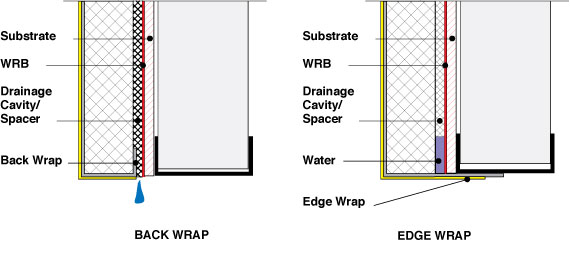
Back Wrapping And Edge Wrapping
Edge wrapping is often used with traditional EIFS. But at the bottom-most edge of an EIFS with drainage wall, it can’t be used as there is no way for the water to get out-the edge is sealed and the water stays between the EIFS insulation and the WRB (see Drawing 1). Not a good thing. Some type of opening is needed to let the water out and thus this edge is usually back wrapped.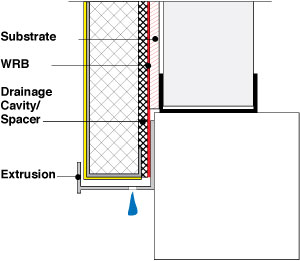
Flashings And Trim
If an object, such as a window frame, is flush with the outside face of the EIFS, or projects past it, or hangs outward of the EIFS-substrate interface, metal or plastic flashings or trim is sometimes used to direct the water to the outdoors.In the case of nail-flange residential windows and thin EIFS layers, sometimes the use of flashings is not desired for a number of reasons and the water is allowed to run horizontally to the window jambs and continue down between the EIFS insulation and WRB. If a multi-story building has a lot of leaky windows, it’s easy to see how the amount of water would increase as the water moves downward, and at some point the water must be gotten out of the wall.
Extruded flashings are available that look like Drawing 2. They produce a clean, hard edge. Holes in the horizontal bottom edge let water drain out. The vertical lip and space on the outside edge is left open, and thus the extrusion acts like a gutter-for water running down the outside face of the EIFS. The water ends up in the gutter and dribbles out the underside of the extrusion, creating a concentrated, dripping effect at the opening below it.
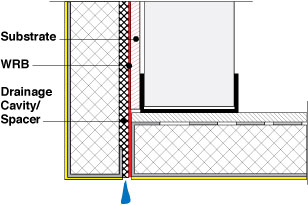
Wall-Soffit Transitions
When a vertical wall stops and turns into a soffit, the soffit might also be EIFS-like at the window head with recessed windows. The water that supposedly is between the EIFS insulation and WRB needs to be gotten out of the wall at this point. There are several ways to do this, such as the open slot shown in Drawing 3. This also acts as a “drip edge.” Note that the WRB needs to be extended slightly downward to the beginning of the slot, so the water can drip out.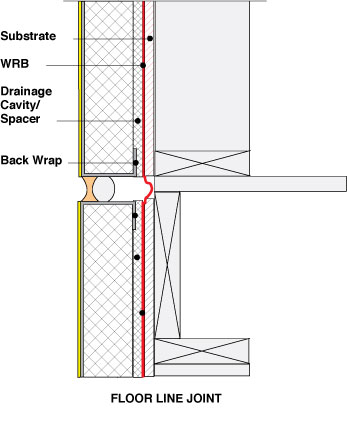
Floor Line Joints In Wood Frame Buildings
In wood frame buildings, a horizontal joint is required at each floor line. With EIFS with drainage, this means a flashing that can accommodate the vertical movement of the joint that is induced by the shrinkage and expansion of the wood framing.A simple Z-shaped flashing will work. This does bring the water to the outside but creates an obvious joint that some people find unattractive. Another solution is to continue the WRB past the joint, let the water flow down to the next story, and then eventually out. To do this, the WRB itself must be flexible enough to withstand the movement. With WRBs made of sheet materials, such as building papers and wraps, a bulge can be added into the paper so that the paper can deflect up or down without tearing (see Drawing 4).
Another way to handle this condition is to stop and start the WRB at the joint area. This method is used when trowel-applied WRBs are used. A flexible, rubber-like membrane is bonded to the substrate at the joint area and can take the movement.
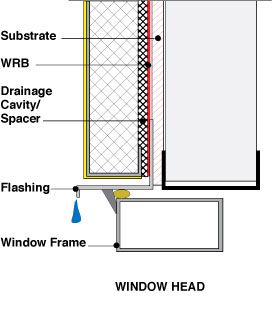
Window Heads
The geometry and position of the various wall elements at window and door heads needs attention in order to work properly and to look decent. If the use of flashings is to be avoided, normal-box, frame-style window and door frames must have their outside face inboard of the WRB (see Drawing 5).Near Grade
The big problem near grade is that bugs can crawl in behind the EIFS and set up shop. One way to thwart them is to use screening as a simple L-shape of flashing.Another issue at grade is the bottom edge of the EIFS getting mashed by people, lawn mowers, etc. To protect the EIFS, a heavy flashing can be used. This gives a hard straight edge.
EIFS Prefab Panel Horizontal Joints
EIFS with drainage creates special problems when prefabricated EIFS panels are used. The multitude of joints between panels makes for a lot of horizontal flashings, which can ruin the otherwise crisp joints between panels. The problem of where and how to install flashings is also a huge issue.If anyone knows of an easy, attractive way to provide the drainage outlet at the bottom horizontal edges of a prefab EIFS panels, I’d sure like to hear about it. Fortunately, EIFS with drainage is used mostly on wood frame residential buildings, and prefab panels are used on taller, commercial buildings.







